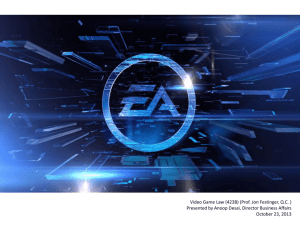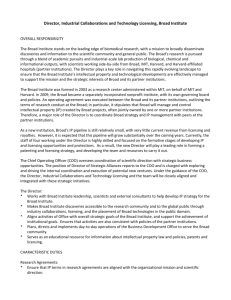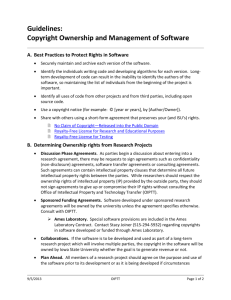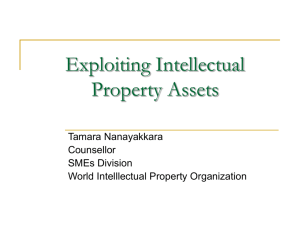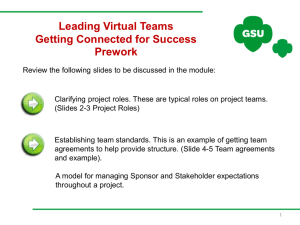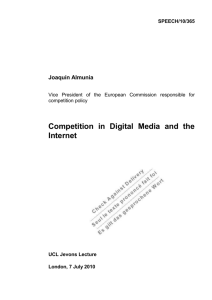DOCX - American University Washington College of Law
advertisement
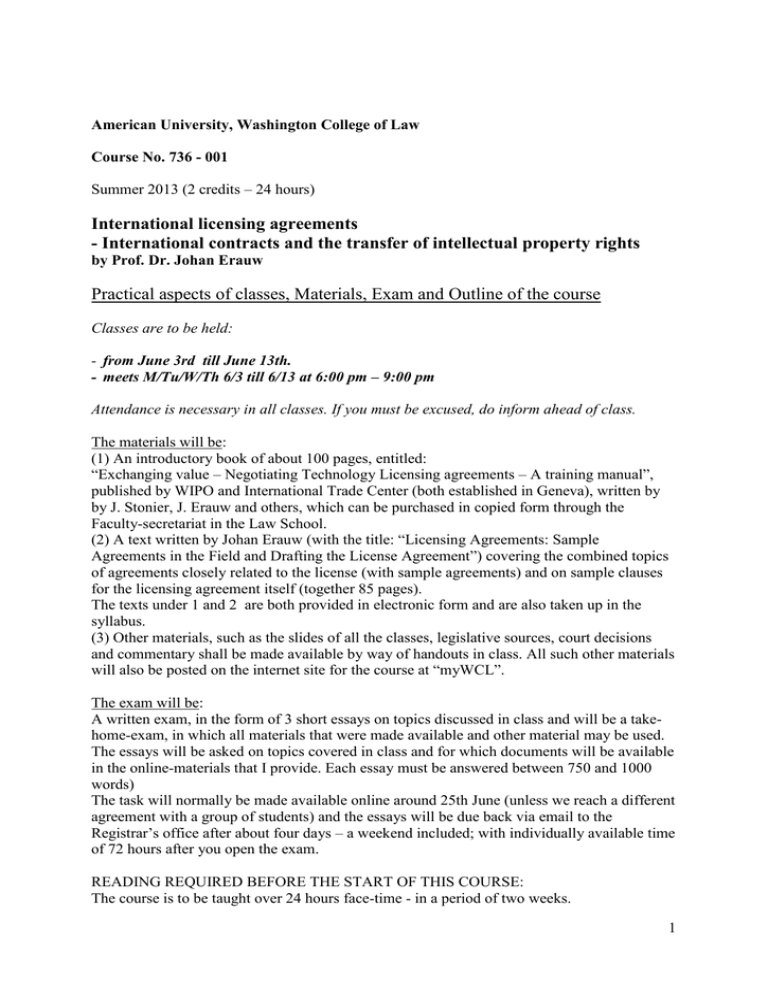
American University, Washington College of Law Course No. 736 - 001 Summer 2013 (2 credits – 24 hours) International licensing agreements - International contracts and the transfer of intellectual property rights by Prof. Dr. Johan Erauw Practical aspects of classes, Materials, Exam and Outline of the course Classes are to be held: - from June 3rd till June 13th. - meets M/Tu/W/Th 6/3 till 6/13 at 6:00 pm – 9:00 pm Attendance is necessary in all classes. If you must be excused, do inform ahead of class. The materials will be: (1) An introductory book of about 100 pages, entitled: “Exchanging value – Negotiating Technology Licensing agreements – A training manual”, published by WIPO and International Trade Center (both established in Geneva), written by by J. Stonier, J. Erauw and others, which can be purchased in copied form through the Faculty-secretariat in the Law School. (2) A text written by Johan Erauw (with the title: “Licensing Agreements: Sample Agreements in the Field and Drafting the License Agreement”) covering the combined topics of agreements closely related to the license (with sample agreements) and on sample clauses for the licensing agreement itself (together 85 pages). The texts under 1 and 2 are both provided in electronic form and are also taken up in the syllabus. (3) Other materials, such as the slides of all the classes, legislative sources, court decisions and commentary shall be made available by way of handouts in class. All such other materials will also be posted on the internet site for the course at “myWCL”. The exam will be: A written exam, in the form of 3 short essays on topics discussed in class and will be a takehome-exam, in which all materials that were made available and other material may be used. The essays will be asked on topics covered in class and for which documents will be available in the online-materials that I provide. Each essay must be answered between 750 and 1000 words) The task will normally be made available online around 25th June (unless we reach a different agreement with a group of students) and the essays will be due back via email to the Registrar’s office after about four days – a weekend included; with individually available time of 72 hours after you open the exam. READING REQUIRED BEFORE THE START OF THIS COURSE: The course is to be taught over 24 hours face-time - in a period of two weeks. 1 This makes it really necessary to read before the start of this course a few model contracts to get acquainted with the material and with the challenges. Read before Monday 3rd June the prescribed text written by myself, on “Licensing Agreements: Sample Agreements in the Field and Drafting the License Agreement”. Short Course Description: This course examines transactions granting the right to use intellectual property rights and their assignment in cross-border business dealings. The course will very briefly explore the general legal aspects of international agreements and build awareness for issues of international jurisdiction and arbitration and for issues of international intellectual property law. Prof Erauw quickly moves on to contracts relating to the exploitation or the transfer of intellectual property rights. Examples of brand-licensing and of authors’ copyright agreements will be given. The main focus will be a detailed analysis of the transfer of technology in patent licensing agreements and assignments of patents. Several types of earlyphase understandings or short contracts are described that prepare for the license or transfer: heads of agreement, contracts to negotiate or option agreements et al. Then the license to use with all its clauses is analyzed. The course gives ample attention to problems of strategy, valuation and negotiation. We focus on legal rules of a mandatory nature that under several national legislations intervene to regulate this field, such as antitrust rules. The last class is built around a negotiation exercise in which students argue and draft mock clauses such as the grant clause and payment clause; and possibly on warranties & representations; innovations; options to expand; liabilities and termination. A student may more easily understand and appreciate issues treated, if (s)he has previously acquired (some) basic knowledge of elements of protection under IPR or patenting in particular; or of issues under conflict-of-laws and international dispute resolution. All those will however not be studied in detail; nor is it strictly necessary to know in advance IP-law in detail or to know conflictof-laws or international procedure. This course can stand alone and may show how further specialization is useful. All-in-all this course is a practical reflection on issues of drafting in the particular field. Debate in class is encouraged and guidance will be provided in understanding also those related issues (and references are given for further reading). Course outline: A. INTRODUCTION 1. 2. 3. 4. Getting acquainted - Making practical arrangements; Reading materials - laws and treaties - model contracts - negotiating file; Presentation of structure and content of the course: broad goals, practical orientation; International contracts for the commercialization of Intellectual Property Rights (“IPR's”) are our focus: assigning rights (transfer) and contracting to give/receive a right to use (“license”). B. THE GENERAL LEGAL FRAMEWORK 1. Litigation awareness ought to be developed - The view from a forum (i.e. a place where binding decisions may be made; thus from where the law is to be imposed); anticipating the 2 problems and forum shopping, plus awareness for international commercial arbitration – These are not the focus of this course. 1 2. An abundance of legal problems: - comparative legal approach (Europe and USA and other) and practical commercial approach; - one must understand what is contract law (obligations) and what is intellectual property law; - there are conflicts of law – solutions in two major fields, namely in Contracts and in Intellectual Property; and there is substantive law (with some mandatory rules in it) in both those fields; - several mandatory rules can/will intervene (inter alia: limits to parties’ contractual freedom coming from the laws on intellectual property; from market protection or protection of weaker parties – such as in developing countries; from labour law or tax laws or coming from competition rules such as antitrust, exhaustion of rights; or imposing registration requirements or minimum duration or maximum royalties and such) and constraints from public policy (mandatory license, military use; moral exceptions). - drafting exercises - determining value – negotiation exercise 1 It is necessary to anticipate the international jurisdiction of state courts and eventually an existing agreement to go into arbitration to resolve disputes in this field. The following aspects will not be discussed in class, but if you would be confused or have questions in this regard; we may discuss outside class hours: (a) International jurisdiction before state courts - General principles; notions in U.S.-law regarding international jurisdiction; Europe’s Regulation 44/2001 on jurisdiction. Knowing the rules on international jurisdiction of state courts gives you the best preparation for probable or predictable locations of procedural battles. Anticipating which courts could be called on by yourself or your co-contracting party is a necessary preparation to understand the international implications of your agreement; it gives you a view of which laws will eventually be called upon; which mandatory rules may apply etc. Knowing beforehand the possible or permitted state court interventions, enables you to set up the agreement in the right way; it gives you guidance and support for your legal reasoning; it allows you to think ahead in terms of probable legal sanctions and difficulties with enforcement or opportunities to apply pressure; (b) Disputes over contractual issues (place of contracting, place of performing and place of work, branch offices and doing business, purposeful availment); (c) Requesting courts to establish validity or invalidity of a patent; Suing before courts on tort issues (place of acting, place of damage, product liability). (d) Forum shopping is important; depending on the court addressed you end up with different position before state mandatory rules; (e) The perspective of enforcement (trans-boundary) - USA & Europe with eventual use of preliminary injunctions - interim relief (attachment); (f) International commercial arbitration: its contractual nature and limits: ad hoc arbitration or institutional arbitration; the legal framework (contract, institutional rules, national rules, international treaties); (g) Special aspects of arbitration in I P R’s: arbitrability of IP-issues before private “judges”; their non-binding nature vis-à-vis third parties; enforceability of such private awards; The greater use in arbitration of the law merchant and some self-regulatory precincts; (h) Enforcement of arbitration awards (New York Convention of June 10, 1958); (i) On-line arbitration and specific IP-arbitration rules (WIPO); (j) Alternative Dispute Resolution: mentality and technique. Advance Reading Materials: - See Lamb and Garcia, Arbitration of intellectual property disputes (available in electronic file); - See the New York Convention June 10, 1958; - See also J. Lew, “Final report on intellectual property disputes and arbitration”, ICC Bulletin (English), 1998, p. 37 – 54. - For the UNCITRAL Uniform rules and the UNCITRAL Uniform Code, consult: http://www.un.or.at/uncitral - For an example of arbitration rules of an institution, consult: http://www.iccwbo.org/arb - Consult: http://www.arbiter.wipo.int/online_dispute; J. Norvell, ”Mediating trade mark cases in the windy city”, Managing I.P. 1998, p. 22–24. 3 C. The LICENSING AGREEMENT in its COMMERCIAL and LEGAL CONTEXT STRATEGIC CHOICES in EXPLOITING or VALIDATING PATENTS 2 1. Business oriented elements of choice: - Understanding the value of intangible assets; defensive (policing, enforcing) or strategic use; - Two major forces at work - striving towards innovation and globalization; - Deepening the knowledge; acquiring the lead in innovation and expanding the geographical field or markets; - Seeking synergies; improving alliances (eventually cross-licensing) in learning and development and in commercialisation; - Contract-oriented questionnaire and preparing licensing negotiations: seeking your partner, field, area, period, application, improvements. 2. The legal aspects of the business context: alternative commercial strategies for the distribution and sale of branded goods and for high-tech (advanced) tangible goods and how we qualify them under the law – note the legal characteristics or issues of these relationships: - cross-boarder distance sales, as per mail-order or online sales; - selling (or just delivering) through employees proper to the firm or via a local office; - by setting up a branch office abroad; - through agency agreements (principal and agent) to conclude external relationships; - via commissioners (undisclosed agents) or e.g. for artwork: via a consignee; - by way of a restricted distributorship (exclusive concession and /or sole purchase); where we have purchase and re-sale; - per franchise agreements (comprising a package of IPR’s); - independently incorporating in a foreign country; - by setting up a joint venture (contractual and corporate). But alternatively, through licensing intellectual property: letting others use copyright (book, music, film) / by assignment or license for the use of industrial IPR's (trademarks or patent rights). 3. Compare for each type: the sharing of commercial risks, investments, liabilities and the fashion of cost-sharing and the commensurate share of income, resp. royalties. D. ATTACKING THE SUBJECT MATTER - RISKS in NEGOTIATING CONTRACTS FOR COMMERCIAL EXPLOITATION - TYPES of CONTRACTS USEFULL for INITIATING TRANSFER of I P R’s or TRANSFER OF TECHNOLOGY3 1. Confidentiality or secrecy-agreement – Analysis of its terms – the need to understand the risks of negotiating in Intellectual Property; Safeguarding know-how, closed room, escrow agreements. 2 Advance Reading Materials: - R. Christou, "Choosing between Agents, Distributors and Licensees", in: International agency, distribution and licensing agreements, 3rd edit., London, 1996, p. 560-571 - M.R. Uhrgynuk and S.H. Sarles, “The United States” in: R. Christou, International agency, distribution and licensing agreements, 3rd edit., London, 1996, p. 521 – 559. - “Contractual issues distinguished from other issues”, in: J.J.Fawcett and P.Torremans, Intellectual property and private international law, Oxford, 1998, p. 545 – 550. (This will be put on Blackboard) - For the contract of sale of goods, consult: www.cisg.law.pace.edu 3 Advised Reading Materials: - see the book "Exchanging Value - Negotiating technology licensing agreements - A training manual" (by J. Stonier and J. Erauw and others), published by the World Intellectual Property Organization ("WIPO") in Geneva, in the Course Materials and on “MyWCL”; - See the Text by Johan Erauw on Licensing, provided in electronic file. - See also the Text by UNCTAD – Licensing with Developing countries , as posted on Blackboard. 4 2. Negotiating or embarking on a pre-contractual relationship – early phase “agreements” – are they binding or not?: - Letters of intent, Memoranda of Understanding, Gentleman’s Agreements, Heads of Agreement, - Agreements to negotiate, - Standstill agreements, - Option agreements – parallels and difficulties 3. Research and development agreements – Government grants and consequences as in BayhDole legislation; 4. Services agreements - as in training of personnel or in engineering agreements or for consultation or expertise or certification services; 5. Joint-venture agreement (ad hoc input and division of proceeds); 6. Material Transfer Agreements – Analysis of terms and the risks they contain 7. Types of Licensing Agreements: - Copyright agreement (author’s or performer’s agreement; agreements to collect royalties with collecting agencies) - Software license – see online examples of up to 50 pages (accession agreements: accept or no play) - Trademark license (brand-name) for products or services - Knowhow licensing agreement - Patent license - Pure (TM or patent -) or mixed /combined licenses; 8. License of Intellectual Property Right and other tied-in obligations. E. WHAT BELONGS TO THE FIELD OF CONTRACTS AND WHAT MAKES OUT PROPERTY RIGHT WHAT IS THE DIFFERENCE WITH TORT IN THIS CONTEXT? 4 1. Delimiting or defining the field of contracts (see power-point slides) 2. Contracts distinguished from the parties bound to those agreements: owners, purchasers, those giving or receiving rights and their capacity to contract, to possess or pass title, to commence or defend legal actions; the issues involving corporations as parties, viz. their valid existence, representation, structure, decision-making, internal relations – such as to their rights to vote and receive dividends tied to shares; mergers, bankruptcy etc.; also eventual transfer of contractual rights to successors in law through sale or assignment or through will or succession. 3. Contracts (agreed obligations inter partes either to give something or to do or not to do something) distinguished from property rights in goods, intellectual property rights, rights in rem, meaning: against all others. 4. Enforcement of contract and contractual damages (breach) versus tort and infringement: (a) Claims under the contract (privacy of contract); in contrast to (b) Claims in tort in general, based on infringement of IPR’s – thus: legal actions against someone with whom there is no contract or in case a contract does exist, then for a claim of damages outside the field of the concluded agreement; or (c) Cases of cumulative damages of such claims based on contractual compensation as well as based on tort; 4 Advance Reading Materials: - U S A: D.D. Siegel, Conflicts in a Nutshell, St. Paul, West Publ. Co., 1994; - Europe: EC Regulation of 22 December 2000 Brussels : be posted on Backboard. 5 (d) Specific aspects of the law - with their own qualifications and remedies; such as the law applicable to “passing-off”, rules of unfair competition, breach of confidence, slander and defamation (sometimes the civil law remedies are combined with criminal law sanctions). 5. Property issues (in rem – jurisdiction and questions of substantive IP-law). 6. Often when a contractual claim or (especially) when a claim in tort is formulated or is started before a jurisdiction, the defendant casts doubt over the validity of the alleged IPRight; then the issues become intertwined. F. WHICH LAW IS APPLICABLE TO AN INTERNATIONAL CONTRACT ? – USEFULL SUBSTANTIVE RULES FOR CONTRACTS ?5 1. The need for comparative conflicts analysis; 2. The role of party autonomy and the mechanism, plus the law applicable to an international contract, absent choice by the parties (see powerpoint slides): - The European “Rome I- Regulation” of 17 June 2008 (Reg. No. 593/2008); - For the U.S.A.: UCC par I-105 – adaptation proposed (May 21, 2008) in par I-301 UCC and conflicts rules such as Restatement second of the conflict of laws (ALI); - Inter-American convention (signed in Mexico City, 17 March 1994) on conflicts law in contracts; 3. Similar conflicts approaches, as in China (law of 28 Oct. 2010), Japan, Switzerland et al.; 4. Sources of substantive international commercial contract law: primarily the UNIDROITPrinciples of International Commercial Contracts (1994, 2004 and 2010); 5. The place of mandatory rules (limits of contractual freedom), the mechanism, the forum; 6. Third-parties vis-à-vis the contract: contracting over rights in rem in general (publicity, registration); 7. Focus on some issues of contract law: Questions of formal validity; 8. Specific contract-types and protected parties: workers, consumers and licensees of technology in lesser-developed recipient countries; 9. Absent protective constructions: which law applies to licensing? (see the powerpoint slides) 10. Conflicts rules for labor contracts (employee inventions and creations – see EURegulation); 11. Contracts may be combined agreements, containing also sales of goods, services, other intellectual property rights (like a trademark-license included into a patent-license agreement or copyright license with manuals or diagrams…): think of Conflict-of-laws rule on sale of movable goods (The Hague, treaty of 21 December 1986 and application of general rules; the role of the CISG-treaty); contracts of work-for-hire (services, expertise). Licensing agreements may also be mixed licenses (license to use a patent, know-how plus a brand etc.). G. INTELLECTUAL PROPERTY RIGHTS AND TRIPS (brief mention – reference to TRIPS in the 1994 WTO-Agreement concluded at Marrakech) - WHICH LAW IS APPLICABLE TO INTELLECTUAL PROPERTY RIGHTS ? 1. Definition, typology, economic value and relevance: 5 Advance Reading Materials on international contracts: See the EU-Regulation; the UCC-provisions and the Treaty of Mexico and other foreign conflicts law: where provided on Blackboard/”MyAU” For excellent substantive law on international commercial contracts in general, consult: www.unidroit.org/english/principles/pr-main.htms - 2010 version of UNIDROIT “Principles of Int. Comm. Contracts”. - Consult the Hague Convention on conflict of laws on sales agreements: http://www.hcch.net/e/conventions/menu27e.htlm - for franchising (in relation to IP) see http://www.his.com/~pildb/ 6 - Industrial property rights: patents; design and models; electronic circuits; plants & biological and agricultural materials - Technical know- Trade Marks - Brand names (goods & services) - Copyright and Neighbouring rights - [New rights being created] - art. 2B UCC Differences between countries, policies, imperative or mandatory elements – Examples from patent-law, trademarks, copyright. The difference between national legislation and community legislation in Europe TRIPS-section of WTO: - Its scope, entry into force; - Its direct / non-direct applicability; - Its substantive intellectual property rights; - Its dispute settlement arrangements.6 2. The national law applicable to the IPR’s – the law of the place where protection is alleged7: a) Which national law applies to patents: - The Paris-convention and its territorial application; - Administrative (historically “letters patent”); - The law of protection (infringements); - always national legislations. b) Which national law applies to Trademarks and brand-names: - The treaties - Trade marks on the wwweb - Which national law governs the competition rules (not in rem and non-contractual) 6 Advance Reading Material on substantive IPR’s: - See an overview of IP Rights in “Exchanging Value – Negotiating Technology Licending Agreements, UNCTAD 2001- by J. Stonier, J. Erauw and others – in the Course Materials and on “MyWCL”; - For European patents and guide on “How to apply for a European patent”, consult: http://www.european-patentoffice.org/ap_gd - For basics of American patent law, consult: http://www.uspto.gov/ for basics of American trademark law: http://www.uspto.gov/web/offices/tac/doc/basis for the patent cooperation treaty: http://www.uspto.gov/web/offices/pac/dapps/pct/wipo.htm - Basics on copyright at: http://www.lcweb.loc.gov/copyright/circs/circ1.html; - Detail on recordation and international aspects: at the same site, but /circ12 ; - Description of the world status of conventions, at the same site, but /circ38a (and see the section 104 of US Act of October 31st, 1988 there). - For general information on intellectual property rights and the existence of the international treaties consult: http://www.wto.org/wto/intellec/intellec.htm http://www.abanet.org:80/intelprop http://www.ladas.com:80/patintl.html http://customs.ustreas.gov:80/imp-exp2/ipr. - Regarding TRIPS, see: H. Wager, “Substantive copyright laws in TRIPS”, in: Trade-related aspects of copyright (H. Cohen Jehoram et al., editors), Deventer, Kluwer, 1996, p. 31 – 40. 7 Advance Reading Material on the applicable law for IPR’s: - J.J.Fawcett and P.Torremans, “Creation, scope and termination of I P R’s”, in: Intellectual property and private international law, Oxford, 1998, p. 483 – 525. - E. Ulmer, Intellectual property rights and the conflict of laws, Deventer, 1990, p. 76 - 102. - The Swiss and the Belgian (draft) rules on private international law (handout). - On customs and ipr-protection, consult: http://www.customs.ustreas.gov:80/imp-exp2/ipr/ - On protection of cultural property: http://www.usia.gov/education/culprop/sindex/97-446.html - J.J.Fawcett and P.Torremans, “The Berne Convention 1886”, Intellectual property and private international law, Oxford, 1998, p. 462 – 475. - On WIPO, see above. - On e-commerce and copyright: J. C. Ginsburg, “Private international law aspects of the protection of works and objects of related rights transmitted through digital networks”, WIPO-document GCPIC/2 (December 18, 1988). 7 - Domain names protected under ICAN-rules but linked to trade names c) Which national law applies to Copyright: - The territorial application of the Berne-convention(s) - The law of protection (infringements) (d) The role of the law of origin with regard to the issue of “inventorship” – who held the original rights; the original title to invention? 3. Transfer of technology – rules of soft law in the code of UNCTAD; 4. Technology and dual-use-technology and export-restrictions (COCOM–rules and embargo); 5. Compare: conflict-of-laws rule for transfer of other intangible goods – like assignment of a claim of a creditor: assignment of receivables. The UNCITRAL-treaty 2001. Third-party rights, namely creditors or claimants in a bankruptcy raise the question of property relationship (rights in rem). H. SOME EXAMPLES OF MANDATORY RULES FOR LICENSING CONTRACTS OR TRANSFER OF IPR’s8 1. Restrictions coming from within the law on IP: maximum duration of protection and cutoff of payment of licensing fees for the IP; independent exploitation for co-proprietors; or protection of indigenous resources e.g. Biodiversity Treaty; non-withdrawal of license; option to prolong etc. 2. Restrictions on agreements made under competition law: Anti-trust regulations in USA and Europe - the block exemption: white, gray and black clauses (the legislative documents are offered online at “my.wcl” with the course 736-001 and should be consulted) 3. No fractioning of the common or integrated market - Exhaustion of IP-rights upon first legally permitted use 4. Assignment of a Trade Mark only in conjunctions with transfer of a business (for fear of transfer pricing – Tax law limitations 5. Obligatory Registration of the license (to be permitted to import or export or e.g. to have effect vis-à-vis third parties; like a licensee suing infringers) 6. Restrictions in materials, in money transfers; maximum royalties or government controls on royalties… 7. Non-transferability of moral rights in copyright 8. Restriction on form for author's copyright in separate media) et alia. I. DRAFTING CONTRACTS for ASSIGNMENT or LICENSING of TECHNOLOGY9 (a) General aspects of contracting in an international environment over intellectual property rights: 8 The following list is only by way of example. Advance Reading Materials: - US and European antitrust-law: (…) - Restricted distribution and exhaustion of rights: (…) - L. Dybdahl, "The transfer of rights and their registration in the European patent and community patent register", 29 IIC (p. 387 - 406) 1998. 9 Advised Reading Materials: - see: "Exchanging Value - Negotiating technology licensing agreements - A training manual" (by J. Stonier and J. Erauw and others); - see the Text by Johan Erauw: International licensing agreements – Part 1 - See also the Text by UNCTAD (Licensing IP) in the Course Materials – and as posted on Blackboard 8 Identifying the Parties and their affiliates (being bound to confidentiality, to be allowed to develop, to produce, to merchandise, distribute.., and to be obliged to pay or otherwise perform) Attention for the pre-contractual phase – contract drafting and the rights of parties whilst negotiating The external formalities necessary for a valid conclusion; Number of original copies; Signing of the contract (signatories) The contract Preamble (“Whereas…”) and its value under the law (which law?) (b) Specific clauses and the questions they resolve: Definitions and their different uses (weighted/accepted legal terms or your shorthand) Warranties and representations (think of co-ownership; academic inventors) (c) The granting provision: Which intellectual property do you give? (use of Addenda) – its description as license for use of brand-name or of copyright or of products or license of patent(s) Types of licenses: Exclusive or not; sole license; license to make, produce; to use; to exploit; to sell, to import and export; or a clause of non-assertion of rights What is the scope of a license? Is the provision of know-how included? The territory or territories of the license The material Field of application and the matter of improvements to an invention Is there eventually a swap of IP-rights? Conditions precedent - commencement of the license What is the duration of the grant? Are there posterior conditions – such as circumstances that may trigger effects or reversal of rights? Tied-in rights and obligations (buying of commodities; products, parts, compensating for training, for product quality controls et al.) Granting options for eventual extensions of a license or assignment Possible right of first refusal granted; freedom to allow applications to others Eventual “most-favoured licensee”-clause Giving or allowing Sublicense (see short text by Yohannan and see court decisions) Due diligence in exploitation: results to be obtained and sanctioning this (d) Financial compensation obligation, reporting and effectuating payment: Issues of valuation (se PPT-slides and short comments posted on Blackboard) Royalties and other financial compensation - lump sums; cost reimbursements; strategies…formulas - types of royalties (tax aspects exempted) – basis of calculation; periodicity etc. - duration of payments under patent and an eventual split-up for know-how - valuation and information sources - negotiation strategies Royalties determined for the case of sublicensing – Royalty share versus royalty rate Reporting on turnover, bookkeeping controls (see short articles posted on Blackboard) International payments and currency problems Price-adjustment to changed circumstances (e) Liability – Enforcement Liabilities in the development Liability for defective technology 9 Liability in case of breach of third-party IP-rights – Costs of lawyering Enforcing and defending the contract vis-à-vis others and covering the legal costs (f) Termination – Exemption - Adaptation Termination of the agreement through end-of-term or breach – eventual unilateral withdrawal rights – winding up - compensation and return of IP-rights and materials Incidence of (risks of) insolvency on the license agreement – acceleration clause Hardship-clause (price-adaptation) and force majeure Survival of clauses (g) Boilerplate stipulations Choice of court (forum)-clauses Eventual arbitration clause Choice-of-law-clause No assignment of rights or as part of assignment of the business Titles have no meaning Four corners clause – no parole evidence – earlier confidentiality obligation Communications between parties (h) Follow-up of the contract – improvements – extensions and exercise of options Compliance and Controls: internal compliance controls and external accountants’ controls J. NEGOTIATING a MOOT COMMERCIAL CASE AND PRACTISE IN DRAFTING A LICENSE AGREEMENT Negotiate a research agreement and license for a new technology in the production of pharmaceutical products, for American University (at which the inventor is employed as an academic) in relation with a Canadian company. The invention is not patented yet and the envisaged application needs further research. The pharmaceutical company will finance the research, hoping this may lead to success for its own product. It also has wider ambitions with the sublicensing to third parties of this technology-platform, if the University is interested in a broader license. The University hopes that further trials with this application may bring the proof of principle for this invention, facilitating the application for a patent. Case materials: A file is prepared with the facts, the parties’ objectives and the restrictions and including the exchange of letters, notes on meetings held and on telephone conversations, plus (in stages) the drafts of an agreement. For the case: The WIPO book Exchanging Value – cfr. Case “A” the relationship between Indico and Chemico. See also the PPT-slides on Negotiation. A brief introduction to the literature regarding negotiations for lawyers will be given on the basis of: R.M. Bastress and J.D. Harbaugh, Interviewing, counseling and negotiating – Skills for effective representation, Boston, 1990, p. 473 – 522 (Chapters 19 and 20: The exchange stage: Preparation / Implementation). -O10
